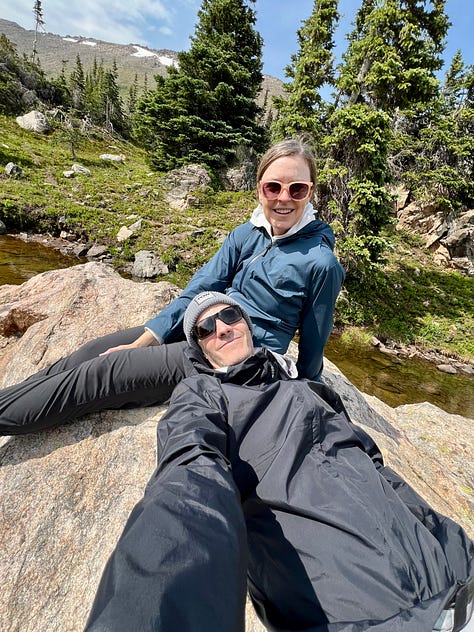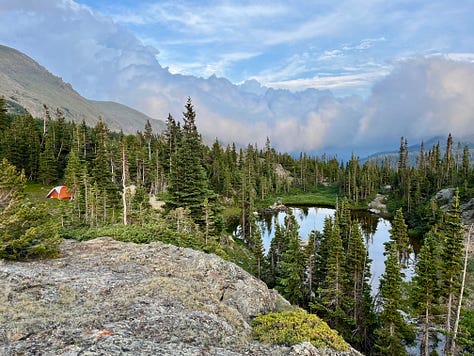The Post-Attention Era is Coming
What if we’re actually about to experience the end of the attention economy?
This email is late, but I have good excuses.
In the last two weeks, I drove all the way to Durango (which takes almost as long as going to Europe) to ride bikes with my wife, stayed around the high country for a few days, took a quick backpacking trip and then finalized the details of a huge life change: Next week I’m starting a new role as VP of Audience Innovation and Development at Teton Gravity Research!





If you’ve been following this newsletter (thank you!), you’ve picked up on the most consistent theme I’ve been trying to tease out – a future-ready vision of the intersection of creators, athletes, digital media and marketing.
Nearly every newsletter has addressed some aspect of this theme – from thinking about macro trends to profiles of the people doing the work. This position at TGR is a chance to experiment with all those variables, and build them around the most iconic film brand in snowsports.
ZeroDraft will continue, and will sometimes touch on projects I’m experimenting with at my day job, but I will continue to explore every avenue of the media ecosystem. I’m excited to join TGR full-time, and to contribute to what Todd and Steve Jones and the team there have developed over three decades.
Today, I wanted to dive into a question that’s been bugging me for a while — what comes after the attention economy?
The Post-Attention Economy
Conventional wisdom holds that we’re living in the “Attention Economy,” and that attention is the world’s most fleeting and valuable currency.
Many of us have pointed out that algorithmic feeds have reduced the importance of owned audience, and have tried to understand a landscape in which a creator with few fans can go viral with the right piece of content, while an athlete who has built a following in the millions can’t predictably reach their fans.
In that environment, your ability to manufacture attention on demand may be the only game in town.
But there’s a growing argument to be made in the opposite direction, too. What if we’re actually about to experience the end of the attention economy?
In a recent episode, creator economy podcasters Colin and Samir argued that “attention is a commodity, but connection is a premium. A creator who can fill a room is worth more than one who can game the algorithm.”
What if we’re actually about to experience the end of the attention economy?
Media companies and platforms have always packaged and sold attention — measured in some variation of how many people saw a piece of content — like a commodity. We have models, tools and language for buying views by the thousand.
The challenge is that attention may be less valuable in the future, for several reasons. AI is flooding the zone with endless low-value content that fights for your attention, while Google search is drying up and social platforms are taking us back into an era of walled content gardens, in which are less likely to move from one place to another. On top of all that, AI agents will eventually take over many online actions. If bad content is unlimited, people are less likely to move around the internet, and AI researches and shops for you, traditional measures of attention may hold less value. What’s the point in getting the “attention” of an AI bot?
BBC Studios’ Jasmine Sun recently argued the value of media “Fandoms”. She runs a content powerhouse that has some of the biggest audiences on both TV and YouTube, yet she’s as focused on long video views, building IP and meme-able content as she is on reach or attention.
Cody Townsend brought this idea into outdoors in a recent Fifty+ newsletter (subscription required).
“Athlete KPIs (Key Performance Indicators) shouldn’t be about how many likes you got this month. They should reflect how local shop kids talk about you. What you’re doing for skiing. How you contribute to the culture, the creativity, the community.”
Community Is the Strategy
While it’s really hard to measure how local shop kids think, for anyone in the business of media, it will become increasingly difficult to convert reach or view count alone into a successful business model.
The linguistic pivot from audience to fandom, from reach to connection, is telling. An audience is passive and attention is fleeting. A fandom, community or connection-driven media landscape should be deeper and longer-lasting.
The outdoor industry has always had aspects of this – film tours that mark the start of a new season, editorial brands that play deeply impactful roles in their sport, athletes who can turn out crowds for an event. Those are all signs of media figures playing a real role in community, not just grabbing attention.
An audience is passive and attention is fleeting. A fandom, a community or a connection-driven media landscape is deeper and longer-lasting.
If the attention economy begins to wobble, content creators will have to build businesses around trust, community and action. Sentimentality for what always worked in the past, or for what your team was “built” to do can be a death sentence. Neil Vogel, the CEO of DotDash-Meredith recently said, “You are not entitled to an audience. You are not entitled to make assets that people don’t want anymore because you want to make them. You have to go to where your audience is and you have to make what they want.”
To succeed, media companies and creators will have to learn to build stories specifically for each community and platform, and to develop collaborations with relevant individuals to bring value into communities.
The Other Side of the Coin
And yet, I don’t want to overstate the likely demise of attention. The ability to monopolize attention is powerful – case-in-point, our current President. The most savvy media operators will still be able to manufacture moments of attention, and gaming the social media attention engine is a significant skill that won’t go away.
After all, while attention without the support of the community is fleeting, a small fandom is amazing but typically struggles to impact culture.
I hope to see a media ecosystem built around deeply interactive fandoms and communities, but with some organizing structures and key moments that help us break out of our groups and impact culture at large. Connection, not insularity, is the goal.
In Other News:
Take a moment to enjoy Second Nature's interview with Amie Engerbretson. Ironically, Amie is also going to be featured in an upcoming ZeroDraft, but there are few athletes who are as savvy about media and sports as she is.
More chances to work for free! YouTube is launching Open Call, a new way to solicit unpaid work. Here’s how YouTube explains it:
Within the creator partnerships hub, place an open call to work with multiple creators in the YouTube Partner Program at once.
Publish a creative brief with campaign details. Once live, creators can proactively respond with video content for your campaign.
Review and approve video submissions.
Promote creator videos as partnership ads and measure results.
So basically, a brand can make an “open call” for content, and creators will deliver free work in hopes of being selected for payment. Sounds great for brands, not so much for creators. YouTube has so much scale that the initiative could work, but I’m skeptical of the output — creator work done on spec, from a creative brief with no conversation or connection with the brand is not a recipe for success.
Marketing Brew had an interesting story about athletes’s LinkedIn strategies. As we know, athletes and creators are businesses now, so it follows that at least some would look to LinkedIn as a potential outlet. Sponsors, marketing managers and decision makers are there and in a business mindset.




